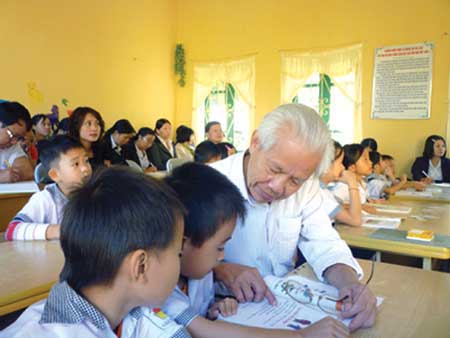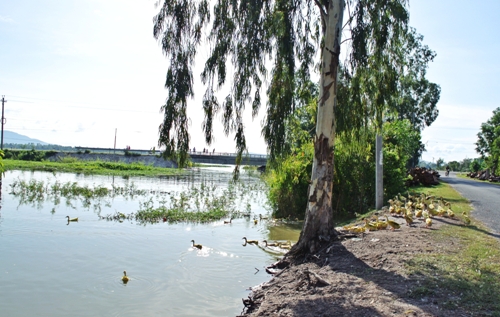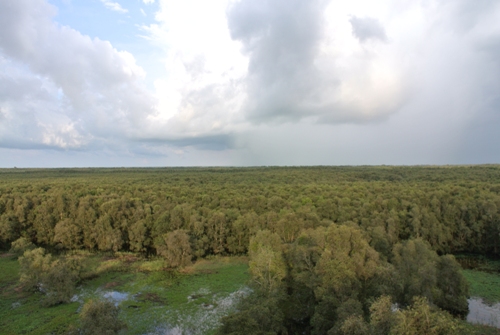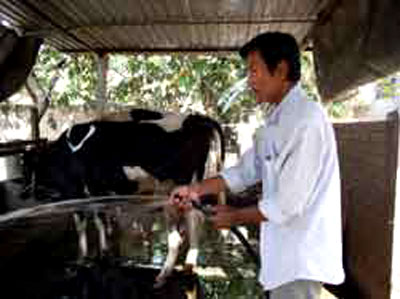|
SHOTS FIRED AS THOUSANDS OF RAMKHAMHAENG UNIVERSITY
STUDENTS AND RED SHIRTS BRAWL
Two men have been shot dead and 54 injured during clashes between anti-government protesters and red-shirt supporters that created mayhem as running battles scarred the streets of inner 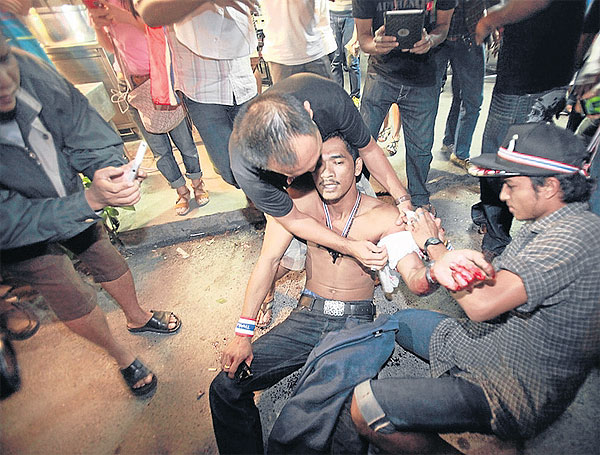
VICTIM OF PROTESTS: A man was
seriously hurt after being attacked yesterday behind
''A 21-year-old man was shot dead by two bullets to his left side,'' said Boonchuay Pochantong, an official at a police station near The violence followed a confrontation between a red-shirt security guard and a Ramkhamhaeng student. It also came on the eve of a ''total seizure'' campaign announced by anti-government protest leader Suthep Thaugsuban. He is urging anti-government protesters to take control of all key government agencies today as part of a ''Victory Day'' push. Nearly 3,000 troops will be deployed to reinforce security in ''From tonight there will be soldiers out to take care of security,'' he said in a televised address, adding that 2,730 military personnel from the army, navy and airforce would take part. Saturday's violence flared in front of the university just after 4pm when a group of red shirts on pick-up trucks bound for their rally site at Rajamangala Stadium appeared to taunt the anti-government protesters. 
A frightened woman pleads
inside a bus as it is attacked by anti-government protesters near Rajamangala
Stadium on Saturday. (Reuters Photo)
Both groups exchanged verbal abuse before a brawl broke out. It was estimated that about 3,000 people were involved in the scuffle, with several people injured on both sides. More violence erupted sporadically throughout the afternoon and early evening as protesters refused orders to retreat into the university compound. A Bangkok Post reporter heard gunshots and what sounded like an explosion near the university at about 8pm. A 29-year-old Cambodian worker and two university students were taken to hospital a short time later with bullet wounds. About 9pm, a third male student was shot in front of Rajamangala national stadium. The worker was apparently a bystander and was shot in the back by a stray round. A witness said he saw a man firing a gun from within a group of red shirt guards who were gathering near the back entrance of the university. The man fired into the air and also at the students. A group of Ramkhamhaeng students also reportedly smashed a taxi window shortly after the initial clash when they spotted a passenger wearing a red shirt. Some students were also seen using wooden clubs and other objects to vandalise a city bus being used by red-shirt supporters to get to the stadium rally site. About 600 police officers were rushed to the scene to restore order. Speaking at the 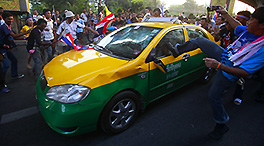
An anti-government protester
kicks a taxi heading for the red-shirt rally near Rajamangala Stadium. (Photo
by Thanarak Khoonton)
The
officers had set up barricades to create a siege situation, he claimed.
Mr Sathit called on demonstrators at He said if Capo fails to control the situation at Ramkhamhaeng, Prime Minister Yingluck Shinawatra and Deputy Prime Minister Pracha Promnok must take responsibility. Ms Yingluck on Saturday affirmed authorities would not use force on demonstrators and called for talks to settle the political problems. Police will handle the situation in accordance with the law, she said. Red-shirt supporters nationwide yesterday began leaving their home provinces to join the United Front for Democracy against Dictatorship (UDD) rally at Rajamangala Stadium, vowing to ''protect democracy'' until the anti-government demonstrators end their campaign. It followed a call by UDD leader Tida Tawornseth for red shirts to put on a show of force in the capital after Mr Suthep earlier told his supporters to lay siege to Government House and all key government offices today. ''I beg all red-shirt sisters and brothers to come out while the Pheu Thai Party is still the elected government and still has power. Or will you come when it is too late?'' Ms Tida said. Jatuporn Prompan, a UDD leader, said the government should not let Mr Suthep besiege government agencies. He said Mr Suthep was trying to entice the government into using violence so the army would be forced to intervene. In Udon Thani on Saturday, Khon Rak Udon Club chairman Khwanchai Praipana, said he was leading about 1,000 people to join the UDD rally in Thousands of anti-government protesters on Saturday occupied the compound of the state telecommunications firm TOT Plc, padlocked the doors of the Department of Special Investigation (DSI), and partially cut off electricity at CAT Telecom. Speaking last night to the crowd at the government administrative headquarters in Chaeng Watthana Road which the protesters have occupied since Wednesday, Mr Suthep urged Bangkok residents to join the 'V-Day'' operation by going to government agencies near their homes at 10.45am on Sunday. He said the protesters would seize 10 government installations, including Government House and the Royal Thai Police headquarters.
People
in other provinces should converge at their respective provincial halls, he
said.
Source: Bangkokpost |
Thứ Bảy, 30 tháng 11, 2013
|
Boy loses 4 limbs, 2 others injured by UXO

Relatives
of Phan Trong Hieu, who lost his four limbs to the explosion, worried after
he was brought to operating room at
Two herdsboys sustained severe injuries while another lost four
limbs when an alleged bomb left from the war era suddenly exploded on
Saturday in central
The accident occurred at 9:30am when the boys were tending a
herd of cows in Ai Nghia town, Dai Loc district.
The victims are Phan Trong Hieu, 11, Phan Van Phuc, 11, and
Ngo Van Phu, 13. The three boys are studying at the local secondary school
Nguyen Trai.
Phuc and Phu are being treated at a general hospital in Quang
Hieu told his father Phan Van Nhi that he and the two other
boys had found an item looking like a mug of water with a string attached.
They said it exploded upon being touched.
In October this year, one schoolboy was killed and another was
seriously injured when an UXO item exploded at their Le Hoa secondary school
in Quang Binh central province. Investigations found that one of the boys had
found an old piece of UXO and brought it to school to play with it during
break time when it exploded.
Official figures show the
Between 1975 and 2000, UXOs killed more than 40,000 people and
injured 60,000 others in
The majority of UXOs are found in the central provinces of Ha
Tinh, Nghe An, Quang Binh, Quang Nam, Quang Ngai, Quang Tri and Thua
Thien-Hue.
TUOI TRE
|
|
Tourism property:
resort developers hit the jackpot
While the other investors get bogged down in
the frozen real estate market, the ones who poured money into high-end
coastal resorts now can pocket big money they earn from the right investment
deals.
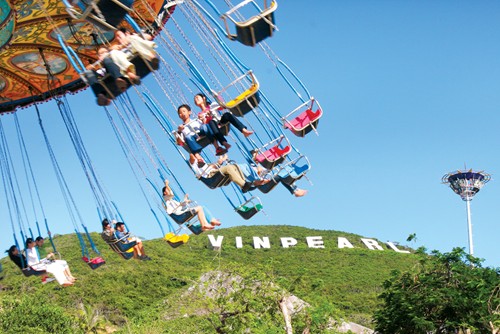
The diagram of average room revenue
of the 4-5 star coastal resorts in the area from
Adam Bury, a senior executive of
CBRE, a real estate service provider, noted a surprise that the average room
rate and room occupancy rate of the coastal five-star hotels in
The average hotel room rate at the
5-star hotels in the area of Da Nang and Hoi An ancient town is now the
highest in Vietnam after making a 3.6 percent increase in 2013.
With 3,800 4-5 star rooms and the
regular room occupancy rate of 70-80 percent, the hotels have been running
very well, which is quite a big surprise in the eyes of the investors who
keep pessimistic in the current difficult conditions of the national economy.
The big changes have created new
“brands” to the area in the
The place where the billionaires
gathered in
With the event, Da Nang has become a
new brand that catches the eyes of the international event organizers as a
tourism city with standardized services: the standard air traffic and in-land
services, the international airport with 47 international and 247 domestic
flights per week, the high end coastal resorts with well known cooks from
Europe managed by foreign groups, the luxurious golf courses nearby and the
ready taxi helicopter service.
Analysts commented that it is a wise
move for coastal resorts to make investments to attract MICE (meeting,
incentives, conference, exhibition) tourists for now, when the world’s
tourism market witnesses a sharp decline.
The conferences of international
organizations or multi-national groups, therefore, have become the “aiming
points” of most of the event organizers and relevant service providers.
The developers of the 4-5 star
resorts and hotels in the coastal area have joined forces to set up a sea
tourism association which gathers the strength of the members to promote
tourism in the area, attract big conferences and international golf
tournaments.
While coastal resorts and hotels have
been prospering, the hotels in the center of the cities, from luxurious to
popular, have to struggle hard to exist. The hotel room rate and the room
occupancy rate of the hotels in the area have tumbled for the third
consecutive years.
Also according to CBRE, the room
occupancy rate there is 20-40 percent, while the average room rate is
incredibly low. Especially, the food and coffee service there have the prices
equal to that at middle class restaurants.
The hotel supply has increased
rapidly by 1,000 3-5 star hotel rooms a year. Hundreds of 1-2 star hotels
developed by the investors from
K. Chi,
|
|
Educational pioneer
makes learning fun
Since founding
Viet Nam's Education Technology Programme based on his experiences in the
former Soviet Union, Professor Ho Ngoc Dai has fought tirelessly to
revolutionise teaching methods, making learning enjoyable for students across
40 provinces.
An older man with a gentle face,
wearing a tawny jacket, walked with deliberate steps across the stage. A roll
of tremendous applause thundered from the audience, accompanying his short
walk to the podium.
Professor Ho Ngoc Dai, an educational
psychologist, went on to make a speech which was very simple but meaningful,
it captured the attention of the audience and moved many, including myself.
"We aim to create an educational
environment that encourages children to go to school without any
pressure," the professor told the attentive audience at the experimental
school, Thuc Nghiem, which was celebrating its 35th anniversary last
Saturday.
Dai is the founder of the Education
Technology Programme (ETP) which aims to help Vietnamese children to access
an education in which the student enjoys going to school.
ETP places students at the centre of
the educational process; the teacher's role is as a conductor with the
children working in concert with one another to gain knowledge.
He recognised the support he has
received from parents and teachers, as he once had to struggle to implement
the new teaching style.
"I would like to express thanks
to parents who have sent their children to
Out with the old
He brought the new ideas back from
his time spent in the Soviet Union where he observed new teaching methods and
innovative ideas in education at Experimental School No91 in
During his study there Dai practised
teaching modern maths for first, second and third grade students and
successfully defended his PhD thesis in 1978 based on that experimental teaching.
He saw the enthusiasm students had
for learning and decided to bring the methodology to
When Dai proposed to apply the method
to Vietnamese classrooms he was met with a reactionary mindset from
individuals and faced particular difficulties when the national education
system was reformed in the 1990s.
He suggested a trial, teaching modern
maths for first grade students, but he said the majority voted against him
and only two were in favour of the new method.
"My educational theory seemed to
be the direct opposite to the national education system.
"My philosophy is the student is
at the centre not the teacher; learning means playing; learning without
examining and without giving a mark," Dai said.
"Meanwhile, the national
education system emphasises the importance of the teacher, forcing students
to learn without considering how they think and focus on giving out marks and
regular examinations. This places too much pressure on the students, as well
as their parents," he said.
Dai's ETP has finally received due
recognition and is now being applied widely thanks to an agreement from the
Minister of Education and Training, Pham Vu Luan.
He said he is very happy because this
year hundreds of primary schools in
Vu Thi Tham, deputy head of the Ho
Tung Mau Primary School in the
"What differentiates this
programme from others is that it helps students develop their own
thinking," Tham said.
"After a two-year trial run,
education managers in the province are confident in the programme because
they realised that students are happy and teachers are interested in
teaching."
She recalled that during the last two
years of the ETP experiment her students felt that they were playing during a
lesson so they understood the lesson very well.
All primary schools in the province
have now used Prof Dai's methodology.
Tran Thi Ngoc Hue, a teacher at the
"Compared with other programmes
they are now able to get meaning of the lesson very quickly.
"For example, they can now read
Vietnamese lessons fluently right from the first term of the school year
while in the past they couldn't even at the year end," she said.
"As a result, the students can
read and write fluently because they are well versed in the rules on
spelling. Not one of them is facing illiteracy,"
"This method creates a positive
mood for both teachers and students who gain the confidence to communicate
with teachers and their friends," she said.
Teacher Nguyen Thanh Huyen of
"As a result, we have much more
time to do research and take on the concerns of our students; we talk more
with them and understand them more. It's very important," Huyen said.
"The programme is really
significant because it helps completely change from how to teach and how to
learn," said Hoang Duc Tung, former head of
In the past a teacher lectured and
read while students wrote, now the teacher acts as a designer and facilitator
and the students work as engineers and builders, Tung said.
Last school year, hundreds of parents
rushed to register their children to study at the school, he added.
Parental praise
Pham Anh Dao, from Ha Noi's Ba Dinh
District, said the school has won prestige for its quality among parents since
its founding 35 years ago.
"I chose this school because
each class has only 40 students and my first grade daughter did not have to
carry a big bag full of books to school. But more importantly is that she did
not have to do exercises at home," Dao said.
She said she had to wake up at 3am to
line up the queue to secure a position for her second child to study here.
Like Dao, Pham Van Thanh in Ha Noi's
Cau Giay District, his family has chosen this school for their two children
because the model respects personality of each student from the first grade.
"My children feel respected when
communicating with teachers. It is one of very few schools in
He added however that he is a little
unhappy because a number of kind-hearted teachers have moved on to work for
other private schools.
"Many more parents have
registered to apply the ET programme next school year," said Ngo Hien
Tuyen, an education expert from the Ministry of Education and Training's
Primary School Department and co-ordinator of the ETP.
Source: VNS
|
|
Tra Su indigo forest, the green banquet in flooding season
Every October-November, tourists flock to the Tra Su indigo forest in Tinh Bien district of the southern province of An Giang to see the green and peaceful indigo forest in the flooding season.
With an area of about 850 hectares, Tra Su indigo forest is covered with a lush green color of duckweeds. This will be an experience you cannot miss when floating on a boat in the indigo forest.
Go to Tinh Bien district, An Giang province, about 100 km from Long Xuyen town. You will see a red soil road leading to the Tra Su indigo forest. Along the road are immense rice fields and tall palm trees. You will see colorful ducks along the road because farmers dye their ducks in yellow, red, green, purple ... to identify their ducks.
Arriving at Tra Su, you will have to walk from the parking lot to the forest gate. Along the sides of the road are lotus ponds and lush green trees.
Boat tickets to the mangrove forests are pretty cheap, only VND50,000-60,000/boat/two hours for a group of 3-5 people. The motorized boats will take visitors deep into the mangrove forests to enjoy the wild and green scenes.
Reaching a small wharf in the forest, visitors will move from the motorized boat to a small boat rowed by hands. From here, the boat will take visitors to the most beautiful area of the forest, where the water surface is covered by duckweeds.
You can touch the duckweeds, admire the bright yellow color of dien dien flowers or watch thousands of birds in the forest.
After moving back to the motorized boat, you will be taken to the observation tower, where you can see the vast forest.
After exploring the mangrove forests, you should visit other tourist sites in An Giang such as the Ba Chua Xu Temple, Forbidden Mountain... or enjoy palm juice.
Photos of the Tra Su indigo forest:
Pha Le
Photo: VNE
|
|
Thailand Protests: Man Shot Dead In Bangkok
Anti-government protesters attack people they think are Red Shirts, who support the prime minister and her brother.
Thaweesak Photkaew, a 21-year-old protester, was killed "by two bullets to his left side", police said.
The violence flared near Bangkok's Rajamangala Stadium which was hosting a rally by thousands of Red Shirts, who support embattled Thai Prime Minister Yingluck Shinawatra.
The Red Shirts - who also back Ms Yingluck's brother, ousted prime minister Thaksin Shinawatra - had gathered en masse to ward of any coup attempt against the government.

At least five people were also wounded by gunshots and five others were injured by knives or rocks, officials at the nearby Dr Panya General Hospital said.
It was not immediately known who fired the shots or whether the victims were supporters or opponents of the government.
Those seeking to topple the government also attacked several people they believed were going to the rally.

Two people were badly beaten and two buses attacked, their windows smashed.
One protester used an iron rod with a Thai flag wrapped around it to smash the driver's side window of one bus.
The buses and one taxi appeared to have been targeted because they carried people wearing Red Shirts.
Police claimed soon afterwards they had the situation under control.
But after dark, attacks continued on individual Red Shirts, and the crowds on both sides grew.
With a Sunday deadline set by demonstrators for the ousting of the government, police called for military backup to protect parliament and Ms Yingluck's office, Government House.
Protesters there tore down stone and razor-wire barriers ahead of a planned move to occupy it.
Demonstrators briefly occupied the headquarters of the army on Friday, urging it to join them in a complex power struggle centred on the enduring political influence of Ms Yingluck's billionaire brother.

The tension heightens a nearly decade-long conflict that broadly pits Thailand's traditional establishment of top generals, royalists and the urban middle class against the mostly rural, northern supporters of Mr Thaksin.
Protest leader Suthep Thaugsuban told supporters late on Friday to surround the headquarters of the national and city police, along with Government House and even a zoo on Sunday.
"We need to break the law a little bit to achieve our goals," said Mr Suthep, a deputy prime minister in the previous government, ousted by Ms Yingluck in a 2011 election.
A crowd of about 2,000 people massed outside state-owned telecommunications companies on Saturday and Mr Suthep has urged his followers to move on the ministries of labour, foreign affairs, education and interior.-News.Sky.com
|
|
In
A study entitled
“Economy and happiness: Evidence from
Married people in rural areas of
A prominent finding of the study
entitled “Economy and happiness: Evidence from
The study found that 45 percent of
people in rural areas of
Professor Finn Tarp, of
The study also found that income
plays a role family happiness. Among those who have the highest incomes, 70
percent said they “relatively” or “very” satisfied with their lives.
Meanwhile, the threshold among the group of people with lower incomes was
only 40 percent.
According to the findings, health,
education and risk management were often tied to income.
“This means that income increases
would foster family happiness if it results in improvements in health,
education and risk management,” Tarp commented.
Those who do farming work on their own
land tended to be happier than wage earners and those who maintain household
businesses.
Similar results were recorded at all
sectors and among both skilled and unskilled workers. Still, the work trend
in the country is moving from agricultural towards wage-labour.
These findings are similar to those
of several other studies in developed countries, which showed that income,
age, health, education, marital status and social network play an important
role in happiness.
Researchers made some proposals including
working out incentive policies to help increase incomes, create better
working conditions and increase autonomy at work.
The study was jointly conducted by
researchers by the Universities of
It was conducted based on the survey
“Vietnam Access to Resources. Household Survey (VARHS)” which was implemented
in rural areas of 12 provinces nationwide between June and July last year.
Source:
|
|
BUSINESS IN BRIEF 1/12
VEC
to embrace restructuring
The
restructuring process of Vietnam’s biggest state-owned highway developer the
Vietnam Expressway Corporation has taken a landmark step forward by getting
the prime minister’s approval to change the capital structures of five of its
major highway projects.
Under
a prime minister decision dated November 8, the capital structures at five
major expressways under the Vietnam Expressway Corporation (VEC) would change
markedly against their formerly approved investment plans.
The
projects cover the building of the Cau Gie-Ninh Binh and Noi Bai-Lao Cai
expressways in the north, and the Ho Chi Minh City-Long Thanh-Dau Giay,
Danang-Quang Ngai and Ben Luc-Long Thanh expressways in the south.
The
government is allowing capital of these projects, including ODA, reciprocal
funds, state budget moneys, and project bonds enacted as direct state capital
contributions to all be restructured.
According
to VEC estimates the total capital is in excess of VND106 trillion ($5.05
billion).
Following
the changes, the state will hold a 49 per cent position in the Cau Gie-Ninh
Binh expressway (open to traffic since June 2012), 29.5 per cent of the Noi
Bai-Lao Cai expressway (to open in mid-2014), 63.05 per cent of the Ho Chi
Minh City-Long Thanh Dau Giay expressway (to open late 2014), 60.5 per cent
of the Ben Luc-Long Thanh expressway, and 60.7 per cent of the Danang-Quang
Ngai expressway (to be completed by 2017).
“The
Ministry of Transport (MoT) has been asked to pen feasible restructuring
plans for each project and re-approve their investment plans after consulting
with the Ministry of Planning and Investment and Ministry of Finance,” said
Prime Minister Nguyen Tan Dung.
The
prime minister also required MoT to study and propose an organisational and
operational model for VEC after restructuring the projects to ensure
efficiency and further attract capital from domestic and external sources
into other highway projects.
According
to deputy chairman of the
Under
the new capital structure, three out of five projects were believed to be
capable of recouping investment within 17 to 32 years. The other two, Noi
Bai-Lao Cai and Danang-Quang Ngai, need further state capital to deal with
pending debts due to the enormous size of the investments and modest traffic
volumes.
Following
the move, the total value including interest of all VEC loans related to
these projects will be around VND57 trillion ($2.7 billion) which should
bring VEC’s chartered capital to debt ratio down by half to 1:57 by 2017.
In a
dispatch from December 26 last year by the Government Office, the prime
minster stressed the need to maintain the operational model and develop a
mechanism to bolster VEC’s financial capability.
“Prime
minister approval will enable the MoT to improve VEC’s organisational and
management model to boost efficiency and further attract domestic and
external capital sources into transport infrastructure development,” Thang
said.
Hiway
launches new capital superstore
Local
company Hiway Vietnam launched its second supermarket in Hanoi last week
after its first, the Ha Dong Hiway Supercenter, launched in October last
year.
Nguyen
Bao Loc, deputy director of Hiway
The
company is a joint venture between the Son Ha Group and strategic
shareholders. Son Ha put $45 million into the complex.
Hiway
Although
it entered
Hiway
stores are located on main traffic routes and feature food courts, fashion
and game centres along with their more traditional supermarket facilities.
From
now through 2016, Hiway plans to open 20 more retail supercenters throughout
the capital and country.
Dinh
Thi My Loan, general secretary of the Vietnam Retail Association, said the
participation of foreign retailers has changd
Giordano
targets early retail entry
Richard
Leech, executive director CBRE told VIR that the size and youthfulness of the
population, growth in middle income earners and rapid urbanisation would make
Giordano
International, Hong Kong’s leading fashion apparel and accessories retailer
in mid-November signed a joint venture agreement with Yeo Boon Liang and
Vietnamese representative Nguyen Thanh Tung on opening retail outlets in
Under
the agreement, Giordano International will hold a 60 per cent stake in the
$600,000 joint venture. Liang and Tung will each hold 20 per cent. However,
the opening date for their first outlet has not yet been made public.
Peter
Kwok Kuen Lau, chairman of Giordano International Limited said that
“By
entering the market early, the company believed that it would be able to
select the best strategic locations and position itself correctly from the
outset with the right brand imaging,” shared Lau.
Lau
added that the company also believed that both Liang and Tung would be able
to offer their assistance in the establishment and operation of the retail
outlets, as both possessed significant experience and knowledge in fashion
retail and supply as well as local infrastructure and systems in
According
to Giordano International Limited, Liang is regional general manager of the
company’s Southeast Asian markets. He is well-connected with international
department stores chains and experienced in running Giordano as an
international brand in
Many
other sectors such as fast food and beverages have also attracted a series of
huge foreign retailers to
The
US-based Dunkin’ Donuts, the world’s top coffee and baked goods chain will
expand its business in
Next
month, leading Filipino food and beverage manufacturers Universal Robina Corp
(URC) will build its third beverage manufacturing facility, with a $35
million investment in the central province Quang Ngai.
URC is
intensifying its Southeast Asian expansion programme in line with plans to
diversify and boost profits, with
Based
on a growth trajectory of 17 per cent a year, URC’s
The
world’s largest fast-food chain McDonald’s is expected to launch its first
Vietnam restaurant in Ho Chi Minh City next February after signing a master
franchise agreement with Ho Chi Minh City-based Good Day Hospitality, founded
by IDG head – Nguyen Bao Hoang.
Philand
Ranh backs out of $30m Pointe91 deal
Philand
Ranh, a subsidiary of the
Deputy
head of Chu Lai Economic Zone Management Authority Do Xuan Dien told VIR last
week that Philand Ranh signed an agreement to back out of the project in
accordance with the authority’s request.
“We
asked the investor to withdraw from the project because the delays have gone
on long enough. Philand Ranh failed to give us a firm time as to when they
would resume construction,” he added.
In
July 2011 Philand Ranh held a ground breaking ceremony starting the
construction of the $30 million Pointe91 resort in Tam Hai commune, five
kilometres from Chu Lai airport.
The
developer said the resort and residential community would include a five-star
hotel, a private residence club with 30 separate cabanas and 227 homes
ranging from 700 to 4,000 square metres, a farmers market, education centre,
and multi-faith worship centre for the local community and international
visitors.
Henry
Fahman, chairman and CEO at Phil Group, in an interview with VIR in July
2011, said the project started with $30 million but would invest a total $350
million into completing its 60-month master plan.
However,
from the beginning the project was plagued with problems. Fahman did not
respond to requests for comment last week, but in an email to VIR in August
he said Phil Group had delayed the project because it wanted to “change the
design and relocate it to a place more appropriate to the current context of
the property and tourism markets.”
Dien
revealed that the
So far
Philand Ranh has completed site clearance and that local authorities and the
developer were working to calculate the cost of the work.
“Once
we find a new developer for this project Philand Ranh can recover these costs
from the new project owner,” he said.
Firms
fume at new duty-free check
All
imported duty-free machines and equipment used for making fixed assets for
projects in
Firms
will face delays in accessing imported machinery due to draft new inspection
rules
At
present, under the existing Law on Customs’ Article 30, all such imported
goods are exempted from customs examination.
However,
according to Vietnam Customs, though this article has made it easier for
investors to implement their projects, especially foreign invested firms, it
has enabled investors to conduct trade fraud by raising the real value of
such imported products.
“It is
necessary to examine all types of imported goods, even duty -free goods used
for constructing fixed assets, to curb fraudulent activities such as transfer
pricing in order to ensure revenue is being sent to the state budget. Of
course, the new regulation will make enterprises unhappy,” said Nguyen Tuan
Sy, head of Dong Nai Provincial Customs Agency’s Inspectorate Division.
“Many
localities have also witnessed enterprises raise the value of their imported
goods used for making fixed assets, while reporting losses from their
business performance to dodge tax obligations,” Sy said. “This has caused
dents in the state budget and affected the country’s foreign direct
investment (FDI) picture.”
Duong
Kim Khanh, a foreign-invested import-export firm representative said many
firms in
“I
think this loophole is one of the causes behind
However,
Khanh said, despite the draft new customs examination regulations,
enterprises could have their own tricks to “bend the law” to benefit
themselves.
“It is
vital that
Foreign
firms snap up Phu My Hung homes
FIEs
are buying apartments for staff in Phu My Hung
A
number of the buyers said they preferred buying property outright as they
could avoid rental payments and could be more flexible in allocating homes to
staff. In addition, the apartments would remain company assets.
In
November alone, FIEs signed contracts to buy 12 Phu My Hung apartments.
Property
developer Phu My Hung Corp. has apartments available in Canh Vien 3,
Riverside Residence, Riverpark Residence and
For
those foreigners that are not eligible to buy residential houses under
Vietnamese laws, Phu My Hung offers a long-term lease contract. If the
tenants later qualify and want to buy a home, the company will help process
the change in ownership form.
During
the fourth quarter this year, Phu My Hung is selling block L, the final block
with golf view in the
On
offer are two apartment sizes measuring 99 and 134 square metres, with
instalment payment options stretching over 2.5 years.
The
apartment project is situated near a golf course, river, the city’s
international commercial and financial district, and Crescent Quarter, which
is home to the
Phu My
Hung has become an iconic
Sudden
rush to buy super-fat pigs by Chinese traders
In the
last two months, Chinese traders have been purchasing large quantities of
super-lard fat pigs from
Since
September, Chinese traders have been flocking to
According
to Thu, owner of a popular restaurant near Huu Lung Quarantine Station in
Le Van
Hung, a small trader in Bac Giang, said that the price of pigs has soared to
VND50,000 per kilo from VND45,000 per kilo in the past week, or upto
VND52,000 per kilo for fine quality from earlier VND38,000-40,000 per kilo.
Local
traders claim that the rise in the price of pigs is because
Currently,
pigs were mainly imported to
At An
Noi Market in Binh Luc District in Ha Nam Province, a famous pig market in
the north where pigs from everywhere in the country are gathered before being
transferred to border gates in the north, the scene has been much more
bustling than on normal days. Trader Vu Van Bao said that Chinese traders
have bought up as many available super-lard fat pigs; hence during the last
month he has delivered a truck load of 100-120 super-lard pigs or 10 tons of
pigs, to
Nguyen
Van Trong, Deputy Head of Animal Husbandry Department under the Ministry of
Agriculture and Rural Development, said that from the point of view of
farmers, a hike in the price of pigs is good news as it helps them to earn
profits. During the last few months, local price of pig was running below
cost price, or even dropped to VND36,000-38,000 per kilo sometimes.
However,
the Chinese market is unstable and can suddenly stop purchasing at any time.
Local traders usually do business with Chinese traders without contracts so
they are totally defenseless. Chinese traders prefer to buy pigs with more
lard with weight of 90-100 kilo upwards as Chinese consumers love braised
pork and roast pork while Vietnamese consumers prefer pigs with more lean.
Therefore, if farmers raise super-lard pigs, their pigs will be unsalable
when Chinese traders stop buying. Thus it is pretty risky if farmers indulge
in raising super-lard pigs due to current price influence, warned Mr. Trong.
Mr.
Trong said that local swine supply still ensures demand at year end and Lunar
New Year festive season. However, the department also suggests that provinces
control export of pork and continue to raise pigs and poultry to assure
market stability at year end.
Nguyen
Manh Hung, Deputy Director of the Department of Agriculture and Rural
Development of Ha Nam Province, said that they have recommended to farmers
not to switch to super-lard swine or let the weight of swine be over 100 kilo
for immediate profits as they will suffer huge losses when
Experts
said that a similar situation in 2011 caused sudden hike in local food prices
while lean-pig supply slumped. Authorities do not want this scenario to be
repeated yet again.
Savills
Viet
Savills
Viet
The
delegation is scheduled to visit projects in
The
visit was planned following a seminar to introduce property investment
opportunities in
The
seminar attracted some 110 guests including Korean finance experts, real
estate investors, banking sector representatives, consultants and developers
who are interested in
At the
seminar, Neil MacGregor, managing director of Savills Viet
"Korean
developers have been active investors in
"This
is being driven by the fact that
"We
are also seeing strong interest from investors looking to purchase good
quality operating assets such as office buildings, serviced apartments and
hotels," he added.
Credit
institutions to shoulder burden of debt restructuring
Governor
of the State Bank of Viet Nam (SBV) Nguyen Van Binh published a plan
addressing directives from the prime minister to manage bad debts and create
an asset management company.
The
prime minister's approval of the projects "Dealing with bad debts in the
credit institutions' system" and "Establishing the Viet Nam Asset
Management Company" was outlined in Decision 843/QD-TTg, dated May 31,
2013.
Based
on this, the SBV governor issued a plan to implement the necessary provisions
(Document 8421/NHNN-TTGSNH), calling on credit institutions (CIs) to develop
and implement plans to settle bad debts and improve credit quality within the
2013-15 period, as part of the overall plan to restructure credit
institutions, according to the Viet Nam Business Forum.
These
changes remain in line with the spirit of the Government's plan to
restructure the credit system.
The governor's
objective is to clear away the current bad debts, effectively control and
enhance credit quality, and successfully meet the objectives of the
restructuring plan.
The
governor has called on banks to assess bad debts and credit quality from
2011, 2012 and the first six months of 2013, including bad debts by credit
level or those created by buying corporate bonds, fiduciary bonds, and
credit.
Bad
debts must also be divided according to collateral value and provisions for
risk. Bad debts with and without collateral must be recorded. Bad debts
classified by state-owned enterprises and other businesses, individuals or
households; bad debts classified by industry; and bad debts incurred by
affiliates, transaction offices, branches and units of CIs will also have to
be recorded.
In
addition, Vietnamese banks are also required to perform analyses and
evaluation of bad debts' data and structure as of June 30, 2013, based on the
following classifications: bad debts defined under Decision 493/2005/QD-NHNN,
dated April 22, 2005, and Decision 18/2007/QD-NHNN, dated April 25th 2007.
This
does not include those bad debts defined by the SBV governor under Decision
780/QD-NHNN, dated April 23, 2012, or bad debts defined under Circular
02/2013/TT-NHNN, dated January 21, 2013, on asset classification, provisions
and the provisioning method, as well as using reserves to handle the risks
associated with the banking activities of CIs and foreign bank branches.
CIs
also need to review, produce statistics, assess the status of loans including
those with interest due but unpaid and added to the total amount of the loan.
Total
debts must also be clearly reported according to classification. CIs must
accurately evaluate the level of risk for loans and the financial situation
and business activities related to them.
In
particular, CIs should propose solutions to deal with the estimated bad debts
and provide an estimate of the number of bad debts that can be resolved with
each solution and for each year up to 2015, including loans sold to the Viet
Nam Asset Management Company.
They
should also create solutions to deal with the bad debts of affiliates,
branches, and other units of credit institutions.
In
terms of improving credit quality, CIs need to develop measures to enhance
the quality of appraisal and lending decisions, including monitoring changes
in credit conditions, record-keeping, processing, procedures, the process of
credit appraisal and approval, and the responsibilities of individuals and
units involved in the process.
Measures
must be adopted to improve monitoring to ensure loans are used for the
purposes stated in their credit agreements.
Finally,
the governor requires CIs to introduce measures to strengthen internal
inspections and control as well as conduct internal audits on credit quality.
For
example, CIs must propose changes in internal control rules and inspection
content and procedures for inspections conducted before, during, and after
the credit approval process.
Methods
must be adopted to handle illegal loans or loans that present a risk to CIs,
including classifying and accounting for these kinds of debts in accordance
with the law, closely supervising the restructuring and handling, creating
mechanisms to help prevent these debts from arising, and putting an end to
the provision of illegal loans.
Sugar
group opposes imports from Laos
Mixed
opinions arose over Hoang Anh Gia Lai Group's recent proposal to the Ministry
of Industry and Trade for an import quota for 30,000 tonnes of sugar from the
group's factory in
The
Viet Nam Sugar Association has suggested the Prime Minister not allow the
import.
In
addition, the association asked the Prime Minister not to permit small-volume
exports of sugar not originating from
This
was in response to Bien Hoa Sugar Company's request for permission to import
crude sugar produced in
The
association estimated the 2012-13 crop to lift the sugar inventory to around
400,000 tonnes and expected the stockpile to remain large after the coming
crop, forecast to amount to 600,000 tonnes.
Together
with the large volumes of smuggled sugar breaching
With
the domestic sugar industry in strife, small-volume exports to
It
said that importing Hoang Anh Gia Lai's sugar manufactured in
The
price of Hoang Anh Gia Lai's sugar manufactured in
However,
chairman of Hoang Anh Gia Lai Doan Nguyen Duc was quoted by Tuoi Tre (Youth)
newspaper as saying the import would have no impact on the domestic sugar
industry because the sugar would all be re-exported after processing.
He
said this would help provide Bien Hoa Sugar Company with raw materials and
that the firm would also pay taxes to the Government.
He
added that according to its World Trade Organisation commitments,
According
to Tran Cong Thang from the Institute for Agriculture and Rural Development
Strategy, domestic sugar production cost were currently high.
The
ASEAN tariff removal scheduled for 2015 would hit the sector hard if domestic
producers could not lower costs and improve quality.
Binh
Duong expects trade surplus
The
southern
By the
year-end, Binh Duong hopes to gain an export value of over $14.44 billion, up
15.7 per cent annually, with the foreign-invested sector making up 81.3 per
cent of the total.
Its
imports are forecast to reach $11.58 billion, with raw materials for
production as well as machinery and equipment adding to a year-on-year
increase of 16.5 per cent.
The
head of the Binh Duong Importers and Exporters Club, Pham Van Xo, said the
club's 156 members had all signed export contracts until the end of the year,
and the apparel, leather and footwear industries had received large orders
for cheap, high quality goods.
Enterprises
must cut production costs, apply modern technology and employ qualified staff
to increase profits, Xo said.
This
year, local leather and footwear enterprises had been producing good designs
and applying modern technology in production and management to reduce risks,
he said.
Binh
Duong's Department of Industry and Trade revealed that the locality had
exported $9 billion worth of goods over the first nine months of this year,
surging 15.6 per cent year-on-year.
Department
Director Vo Van Cu attributed the performance to stable foreign exchange
rates and falling material prices and interest rates, as well as recovering
foreign markets such as the
During
the reviewed period, the province's imports saw a yearly increase of 16.5 per
cent to $7.8 billion, resulting in a trade surplus of $1.2 billion.
Listed
companies post big losses
The
losses marked a 50 per cent rise against the same period last year, with 131
of the 661 listed companies (excluding banks and funds) finding themselves in
the red.
PetroVietnam
Construction's (PVX) losses alone reached more than VND2.6 trillion ($122.6
million).
It was
closely followed by Petroleum Saigon Construction And Investment (PSG),
steelmaker Pomina (POM), Viet Nam Ocean Shipping (VOS) and Mientrung
Petroleum Construction (PXM).
PetroVietnam
subsidiary pays 10% dividend
PetroVietnam
Drilling Services (PVD) plans to issue 25 million shares next month to pay
dividends at 10 per cent.
During
the first nine months of this year, the company earned revenues of VND10.4
trillion (US$490.5 million) and VND1.48 trillion ($69.8 million) in profit.
It
expect to make a year-end profit of VND1.8 trillion ($84.9 million), a 32.4
per cent increase on its initial target.
Military
Bank's investment arm increases capital
Investment
fund MB Capital was granted a licence to double its charter capital to VND200
billion ($9.4 million) by issuing 10 million shares, according to the State
Securities Commission.
The
move is aimed to develop the firm's financial capacity so that it can set up
more unit funds.
Military
Bank (MBB) currently holds a dominant 82.26 per cent stake in the fund. MB
Capital earned profits of VND21 billion (nearly $1 million) in the first nine
months of this year.
Real-estate
firm expands business operations
Property
developer An Duong Thao Dien (HAR) will buy a 51 per cent stake (equivalent
to VND25.5 billion – US$1.2 million) in Ascentro Investment and Trading Co.
By so
doing, it expands its business into agriculture and forestry.
In
June, An Duong Thao Dien spent VND27 billion ($1.27 million) on a 40 per cent
stake in Binh Dinh Mechanic and Mineral Co, hoping to reap a 35 per cent
profit. An Duong Thao Dien's profits for the first nine months reached
VND10.75 billion ($507,000), just 18.3 per cent of its yearly target. The
below-par figure was attributed to declining real estate operations.
Nation
has potential for green development
Speaking
at a seminar on local economic development in
Nguyen
Quang, director of the UN-Habitat program in
During
the 90s,
David
Devine, Ambassador Extraordinary and Plenipotentiary of Canada to
Small
and medium-sized enterprises (SMEs) are the motivation of employment,
economic growth and poverty reduction. Therefore, they should receive the
necessary support from local authorities.
“We
have cooperated with Soc Trang and Ha Tinh provinces to support SMEs, raise
competitiveness in the agriculture industry, assist farmers and push up green
development,” Devine added.
Office
rents increase on lower supply
Office
rents in HCMC are expected to increase in the coming time as supply from new
office building projects becomes lower, industry insiders said.
Greg
Ohan, director of office service unit of CBRE Vietnam Company, said that
office building supply has declined as many projects have fallen behind
schedule. Meanwhile, existing buildings have seen occupancy ratios increasing
sharply.
A
survey conducted by the market researcher shows that new office leasing area
this year had reached around 81,000 square meters as of the end of the third
quarter, up 25% from that in the whole 2012. Office rents also increased
around 3% against the previous quarter, with grade A office rents offered at
around VND680,000 per square meter and grade B at around VND388,000 a square
meter.
Most
customers are those moving to new offices or expanding their offices while
the number of new clients is low. For CBRE, the number of its customers
moving offices accounted for around 44% of 122 transactions made this year,
Ohan said.
Located
at the corner of Ton Duc Thang and Le Thanh Ton streets,
CBRE
said that 175 buildings with around 175,000 square meters of office space
will be launched in HCMC within the next two years. Of which, many buildings
will include head offices of investors, so supply will be limited.
The
city has seen many big projects underway, including The One HCMC complex
developed by Bitexco Group. The project will have a commercial center,
offices, serviced apartments and a five-star hotel.
Mario J.
Lotti Jr, director of the project, said that the foundation of the building
is being constructed. Therefore, the project will not show up on the market
until next one or two years.
FMCG
rises in cities, unchanged in countryside
The
fast-moving consumer goods (FMCG) segment continued to stay unchanged in
urban markets while it experienced strong growth in rural areas, according to
a report by the market research company Kantar Worldpanel.
In
particular, the FMCG market in urban areas had struggled to maintain growth
of 11% while the market in rural areas had grown firmly with a rise of 14% in
value.
Kantar
Worldpanel made its survey during a 12-week period ending on October 6,
expecting the FMCG market to partly regain growth motives to continue the
high growth if the economic situation keeps showing positive signals from now
until the year-end.
According
to the enterprise, except for traditional markets, all major retail channels
had maintained double-digit growth rates.
Manufacturers
make huge investments annually in developing new products to meet the rising
diversified demand of consumers, said Kantar Worldpanel. This explains why
the speed of launching new products is pretty impressive, with one new item
introduced every two hours.
Kantar
Worldpanel studied shopping habits of consumers for over 100 types of FMCG at
2,350 urban households in HCMC,
Imported
food market under inspection
The
Ministry of Industry and Trade will apply strict regulations on the quality
of imported foods from December 20.
Beverages,
vegetable oil, starch and dairy products as well as their packaging will be
subject to inspection. Products which fail to meet standards, as well as
those from areas with polluted water sources or infectious diseases will be
tested for their safety.
Other
products will go through the same process until they are proven their quality
during at least two consecutive inspections, or have been given approval from
the Ministry of Industry and Trade. After that, they will be checked for
labels and origins.
If the
products are not approved, traders will be within their rights to file
complaints and ask for another inspection.
As the
year's end approaches and people start shopping for Tet Holiday, the demand
for food increases. It is also typically a time for high activity for
smugglers and unethical traders to make profits with poor quality products.
In
years past, food hygiene and safety have become one of the most urgent
problems in
Imported
dairy products such as Abbott, Dumex, Similac, GainPlus EyeQ, which account
for 70% of market share, are under suspicion of being contaminated. This
problem has raised the most public concern because it directly affects the
health of mothers and children.
Gun
primed on credit growth race
A
looming rush to achieve the annual credit growth plan might dig
By the
end of the third quarter many commercial banks were still behind their credit
growth targets, some were under 50 per cent. A few are facing negative growth
including Navibank, Saigonbank, PGBank, and Southern Bank.
In
terms of the national credit growth target of 12 per cent, 8 per cent has
been achieved. In capital terms, another $760.6 million needs to be lent.
Financial experts are worried that in their push to make up the difference,
banks may neglect credit quality.
According
to economic expert Vu Dinh Anh, a similar problem occurred in 2011 when the
State Bank announced a credit growth limit for 2012. The race to lend toward
the end of the year resulted in credit shrinking by 2.25 per cent in the
first quarter of 2012.
Again
this occurred in late 2012 when credit jumped by 6 per cent with an annual
national target of 9 per cent. This strongly indicates growth did not reflect
true demand.
“Credit
growth this year should be only 9-10 per cent. Most important is credit
quality, and if this is ignored, bad debts will mount over the next 3-6
months,” said Anh. “The biggest issue is if the State Bank loosens monetary
policy, the economy may suffer serious consequences,” he added.
According
to Nguyen Thi An Binh, deputy general director of Military Bank, a possible
way to grow credit quickly and safely would be to disburse at least some of
the vast amount of capital planned for government projects in transportation
and construction. Military Bank has achieved credit growth of 8.8 per cent in
the first nine months of this year.
Bad
debts are still the main obstacle between bank capital and the marketplace.
“Banks cannot risk lending to customers who may not pay as they have to
provision 100 per cent of the loans,” said Le Xuan Nghia, member of the
National Financial and Monetary Policy Advisory Council.
“If
NPLs are dealt well, credit growth of next year can reach 14-15 per cent,”
said Nghia.
InterContinental
stonewalls Keangnam hotel queries
The
operator of the country’s tallest hotel is still in question despite the
involvement of InterContinental Hotels Group in the project for a few years.
In
August this year then director of sales and marketing of the InterContinental
Hanoi Landmark 72 Jessica Koh told VIR that the hotel was expected to open in
the fourth quarter this year. Koh has recently been appointed as director of
sales and marketing for InterContinental Nha Trang Hotel, which is expected to
open in the next few months.
Odd
activities were seen last week as the billboard bearing the InterContinental
name was moved out of the Keangnam Landmark 72, the tallest building in
There
were reports that employees who had been hired over recent months had been
dismissed and only one person remained. But VIR was unable to contact company
sources despite repeated calls.
A
source from Keangnam Vina, the developer of the hotel, confirmed with VIR
that the team had moved out.
The
hotel occupies the space at the very top of the country’s tallest tower
perched on floors 62-71. It boasts 359 rooms, a variety of restaurants, and
state-of-the-art meeting facilities. Offices and serviced residences occupy
the lower part of the 72-storey building.
Keangnam
Vina has advertised the logo of the InterContinental on the fence of the
complex since the company started construction more than five years ago.
A
representative of the InterContinental Hotels Group Clarence Tan, chief
operating officer for South East Asia & Resorts on the other hand said
the company was still working with property owners and planning to open the
hotel.
“We
will be better positioned to share more information on the hotel at a later
stage,” Tan said, declining to add more information.
Discussing
the group’s development strategy in
“Although
our focus market is
At
present, the group is operating three InterContinental hotels in
In
addition to InterContinental, the group is also operating two other hotels
under Crowne Plaza brand, including one resort in Danang and one hotel in
Hanoi.
‘Cheated’
buyers spark disputes
The
ailing real estate market is facing new challenges with the number of
conflicts and disputes on the rise.
Disagreements
between property developers and residents have centred around management
fees, usage of public facilities, and property valuations.
Some
of the more prominent were the Keangnam Palace, Golden Westlake, and Sky City
Towers.
Recent
conflicts included tempers flaring at the Sparks residential complex in Hanoi
after customers said they were displeased with the calculations of space.
The
developer did not cut out heavy duty columns and common utility rooms and
spaces from the payable area for buyers.
A
similar situation arose at the 928 unit Hyundai Hillstate project after
buyers refused to pay for areas taken up by walls and utilities.
General
director of PMC Nguyen Hong Minh said misunderstandings about the definition
of public and private area ownership are often the main cause of disputes.
Other
conflicts, such as at the Golden Westlake or Keangnam Palace, have been over
management and parking fees.
At
Pacific Place, another high-end residential project, residents requested the
Vietsing medical clinic in the basement and the Rooftop restaurant and bar on
the roof be closed, and were unhappy about the intrusion from three elevators
being added to the adjoining office building.
Residents
were concerned about medical waste from the clinic, complained that the bar
was too noisy despite closing before midnight, and criticised the structural
changes because of the new lifts.
According
to Tran Huu Huynh, chairman of the Vietnam International Arbitration Centre,
property disputes have become more prevalent and specific. This has resulted
in constant battling between developers and residents.
Former
Deputy Minister of Natural Resources and Environment Dang Hung Vo added that
the disputes were becoming increasingly complicated, to the point that
resolution was impossible.
Vo
blamed the problems on unclear and overlapping laws and regulations.
Nguyen
Truc Hien, an executive partner from law firm Vilaf Hong Duc said many
developers draw up contracts that prioritise their interests and push risks
and disadvantages on to buyers.
Lawyer
Phan Vu Anh, former head of the Legal and External Affairs Department from
Vinaconex agreed with Hien, saying that property contracts highly favoured
developers.
“Buyers
are signing contracts they don’t understand and are being cheated,” Anh said.
Hien
said the legal system at current did not have the comprehensive regulations
needed to protect buyers’ rights and that supervisory bodies were
incompetent.
Dao
Ngoc Chuyen, a lawyer and arbitrator from the International Arbitration
Centre agreed that poor management of the real estate market was to blame.
“Over
the last decade, speculation has been the driving force behind the market and
many businesses with little or no experience in property development jumped
in. This inexperience has caused numerous disputes,” Chuyen added.
Before
conflicts can be resolved, Vo said buyers’ rights need to be protected and
there needs to be detailed guidelines for contracts that are fair to both
developers and buyers.
“This
is a complicated issue, but it must be solved and we should start now. All
sides [developers, buyers, policy makers] need to get serious and recognise
that everyone will benefit from mapping out solutions,” Vo concluded.
Source:
VEF/VNA/VNS/VOV/SGT/SGGP/Dantri/VIR
|
Đăng ký:
Bài đăng (Atom)
